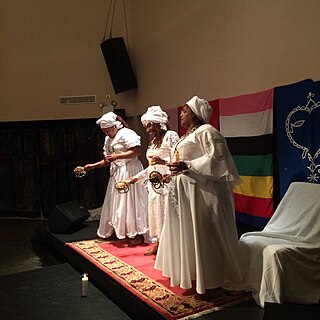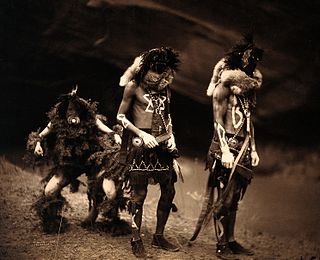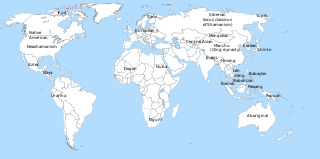
The veneration of the dead, including one's ancestors, is based on love and respect for the deceased. In some cultures, it is related to beliefs that the dead have a continued existence, and may possess the ability to influence the fortune of the living. Some groups venerate their direct, familial ancestors. Certain sects and religions, in particular the Eastern Orthodox Church and Roman Catholic Church, venerate saints as intercessors with God; the latter also believes in prayer for departed souls in Purgatory. Other religious groups, however, consider veneration of the dead to be idolatry and a sin.
This article is about the spiritual beliefs, histories and practices in Kwakwaka'wakw mythology. The Kwakwaka'wakw are a group of Indigenous nations, numbering about 5,500, who live in the central coast of British Columbia on northern Vancouver Island and the mainland. Kwakwaka'wakw translates into "Kwak'wala-speaking tribes." However, the tribes are single autonomous nations and do not view themselves collectively as one group.

Dreaming is a term devised by early anthropologists to refer to a religio-cultural worldview attributed to Australian Aboriginal beliefs. It was originally used by Francis Gillen, quickly adopted by his colleague Baldwin Spencer and thereafter popularised by A. P. Elkin, who, however, later revised his views. The Dreaming is used to represent Aboriginal concepts of Everywhen during which the land was inhabited by ancestral figures, often of heroic proportions or with supernatural abilities. These figures were often distinct from gods as they did not control the material world and were not worshipped, but only revered. The concept of the dreamtime has subsequently become widely adopted beyond its original Australian context and is now part of global popular culture.

The Ghost Dance was a new religious movement incorporated into numerous Native American belief systems. According to the teachings of the Northern Paiute spiritual leader Wovoka, proper practice of the dance would reunite the living with spirits of the dead, bring the spirits to fight on their behalf, end westward expansion, and bring peace, prosperity, and unity to Native American peoples throughout the region.
Indigenous music of North America, which includes American Indian music or Native American music, is the music that is used, created or performed by Indigenous peoples of North America, including Native Americans in the United States and Aboriginal peoples in Canada, Indigenous peoples of Mexico, and other North American countries—especially traditional tribal music, such as Pueblo music and Inuit music. In addition to the traditional music of the Native American groups, there now exist pan-Indianism and intertribal genres as well as distinct Native American subgenres of popular music including: rock, blues, hip hop, classical, film music, and reggae, as well as unique popular styles like chicken scratch and New Mexico music.

Wovoka, also known as Jack Wilson, was the Paiute religious leader who founded a second episode of the Ghost Dance movement. Wovoka means "cutter" or "wood cutter" in the Northern Paiute language.
The Arapaho are a tribe of Native Americans from the western Great Plains, in the area of eastern Colorado and Wyoming. Traditional Arapaho music, described by Bruno Nettl, includes sacred and secular songs. Traditional music uses terraced descent type melodic motion, with songs consisting of two sections, each with a range of more than an octave and scales of four to six tones.

Indigenous Philippine folk religions are the distinct native religions of various ethnic groups in the Philippines, where most follow belief systems in line with animism. Generally, these indigenous folk religions are referred to as Anitism or Bathalism or the more modern and less Tagalog-centric Dayawism.

A mambo is a priestess in the Haitian Vodou religion. Haitian Vodou's conceptions of priesthood stem from the religious traditions of enslaved people from Dahomey, in what is today Benin. For instance, the term mambo derives from the Fon word nanbo. Like its West African counterpart, Haitian mambos are female leaders in Vodou temples who perform healing work and guide others during complex rituals. This form of female leadership is prevalent in urban centers such as Port-au-Prince. Typically, there is no hierarchy among mambos and houngans. These priestesses and priests serve as the heads of autonomous religious groups and exert their authority over the devotees or spiritual servants in their hounfo (temples). Mambos and houngans are called into power via spirit possession or the revelations in a dream. They become qualified after completing several initiation rituals and technical training exercises where they learn the Vodou spirits by their names, attributes, and symbols. The first step in initiation is lave tèt, which is aimed at the spirits housed in an individual's head. The second step is known as kouche, which is when the initiate enters a period of seclusion. Typically, the final step is the possession of the ason, which enables the mambo or houngan to begin their work. One of the main goals of Vodou initiation ceremonies is to strengthen the mambo's konesans—knowledge that determines priestly power.

Kuksu, also called the Kuksu Cult or Big Head, was a religion in Northern California practiced by members within several Indigenous peoples of California before and during contact with the arriving European settlers. The religious belief system was held by several tribes in Central California and Northern California, from the Sacramento Valley west to the Pacific Ocean.
Dancing in Zimbabwe is an important aspect of the Zimbabwean culture, tradition, spirituality and history. There are many dances that reflect the culture of the people, although the dances may have changed throughout the years. Ethnic diversity is also a key factor in influencing the dances of the Zimbabwean culture. These dances are self-reflective, for the entire community because all music and dance are communal events. Dance to Zimbabweans is a very spiritual, powerful tool that carries on traditions, and chronicles the important events of their history and culture.

Native American religions are the spiritual practices of the indigenous peoples of North America. Ceremonial ways can vary widely and are based on the differing histories and beliefs of individual tribes, clans, and bands. Early European explorers describe individual Native American tribes and even small bands as each having their own religious practices. Theology may be monotheistic, polytheistic, henotheistic, animistic, shamanistic, pantheistic or any combination thereof, among others. Traditional beliefs are usually passed down in the forms of oral histories, stories, allegories, and principles.
Ghost sickness is a cultural belief among some traditional indigenous peoples in North America, notably the Navajo, and some Muscogee and Plains cultures, as well as among Polynesian peoples. People who are preoccupied and/or consumed by the deceased are believed to suffer from ghost sickness. Reported symptoms can include general weakness, loss of appetite, suffocation feelings, recurring nightmares, and a pervasive feeling of terror. The sickness is attributed to ghosts or, occasionally, to witches or witchcraft.

The Native American Church (NAC), also known as Peyotism and Peyote Religion, is a Native American religion that teaches a combination of traditional Native American beliefs and Christianity, with sacramental use of the entheogen peyote. The religion originated in the Oklahoma Territory (1890-1907) in the late nineteenth century, after peyote was introduced to the southern Great Plains from Mexico. Today it is the most widespread indigenous religion among Native Americans in the United States, Canada, and Mexico, with an estimated 250,000 adherents as of the late twentieth century.
Brooke "Medicine Eagle" Edwards is an American author, singer/songwriter and teacher, specializing in her interpretations of Native American religions. She frequently teaches workshops at New Age and other events.

Shamanism among Alaska Natives was particularly important as it served to construct their special connection to their land, and a kinship with the animals with whom they share that land. Before the introduction of western culture and the religions that are now practiced in Alaska, there was a common spiritual connection made with the people to the land they occupied. The most common name for this connection is shamanism. Shamanism differs in every culture where it is practiced, in Alaska it is centered in the animals that are common in the area. Through the use of many myths, stories, and ceremonies these animals are personified and their spirits made tangible and in turn are deeply woven within the Native Alaska people today. It was through the shaman that the spirit world was connected to the natural world. A shaman in Alaska Native culture was a mediator, healer and the spirit worlds’ mouthpiece. Although shamanism is no longer popularly practiced, it was and continues, to be the heart of the Native Alaskan people.
The traditional Jamaican Maroon religion, otherwise known as Kumfu, was developed by a mixing of West and Central African religious practices in Maroon communities. While the traditional religion of the Maroons was absorbed by Christianity due to conversions in Maroon communities, many old practices continued on. Some have speculated that Jamaican Maroon religion helped the development of Kumina and Convince. The religious Kromanti dance is still practiced today but not always with the full religious connotation as in the past.
Convince, also known as Bongo or Flenke, is a religion from eastern Jamaica. It has roots in Kumina and Jamaican Maroon religion.
Kromanti dance or Kromanti play is a Jamaican Maroon religious ceremony practiced by Jamaican Maroons. It is rooted in traditional African music and religious practices, especially those of the Akan people of Ghana. The name Kromanti derives from Kormantin where a historical slave fort in the coast of Ghana was located. Many slaves shipped to Jamaica during the Atlantic Slave trade originated from present–day Ghana in West Africa.

Shamanism is found in many countries around the world, in different regional forms.










